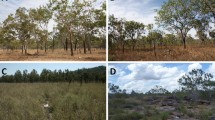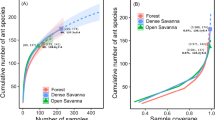Abstract
Although it is common for ant surveys to uncover previously uncollected species, a recent study of subterranean ants in Amazonian Ecuador has indicated that an entire ant fauna may remain largely undiscovered. Here we report on the first systematic investigation of subterranean ants in northern Australia, in order to assess the extent to which the high abundance and diversity of subterranean ants in Amazonia is apparent in tropical Australia. We use a novel sampling technique that combines elements of an attractant bait and a pitfall trap, and allows many traps to be deployed simultaneously. Our main study was conducted at three closely approximated sites in Darwin, where the local ant fauna has been intensively surveyed using conventional (above-ground) sampling techniques. The 720 traps deployed resulted in 421 species records, representing 29 species from 17 genera. Sixteen of these species have cryptobiotic morphology, with four recorded here for the first time. Remarkably, one of these four (a blind species of Solenopsis) was the second most frequently caught species in subterranean traps, with 70 records. Ant abundance, species richness and composition varied markedly between sites, despite site similarity in soils and vegetation. Total ant records were greater in the middle compared with start of the wet season, declined with depth, and were greater after 4 days than one. Sampling at six sites in the Mitchell Falls area of the northern Kimberley region, 1,200 km southwest of Darwin, also revealed several cryptobiotic species new to science, including a new genus record (Pseudolasius) for Western Australia. Our underground sampling has therefore revealed an abundant and diverse subterranean ant fauna in northern Australia, containing many cryptobiotic species not previously collected. We use our results to provide methodological guidelines for most effectively sampling this fauna. Combined with the Amazonian study, our findings indicate that a specialist subterranean ant fauna, including numerous species remaining to be discovered, might be a feature of tropical landscapes throughout the world.
Similar content being viewed by others
References
Andersen AN (1992) The rainforest ant fauna of the northern Kimberley region of Western Australia (Hymenoptera: Formicidae). J Aust Ent Soc 31:187–192
Andersen AN (2000) The ants of northern Australia: a guide to the monsoonal fauna. CSIRO Publishing, Collingwood
Andersen AN (2007) Ant diversity in arid Australia: a systematic overview. In: Snelling RR, Fisher BL, Ward PS (eds) Advances in ant (Hymenoptera: Formicidae) systematics: homage to E. O. Wilson—50 years of contributions, vol 80. Memoirs of the American Entomological Institute, Gainesville, FL, pp 19–51
Andersen AN, Majer JD (1991) The structure and biogeography of rainforest ant communities in the Kimberley region of northwestern Australia. In: McKenzie NL, Johnston RB, Kendrick PJ (eds) Kimberley rainforests of Australia. Surrey Beattie & Sons, Sydney, pp 333–346
Andersen AN, Majer JD (2004) Using invertebrates as bioindicators in land management: ants show the way Down-Under. Front Ecol Environ 2:291–298
Andersen AN, Patel AD (1994) Meat ants as dominant members of Australian ant communities: an experimental test of their influence on the foraging success and forager abundance of other species. Oecologia 98:15–24
Andersen AN, Reichel H (1994) The ant fauna of Holmes Jungle, a rainforest patch in the seasonal tropics of Australia’s Northern Territory. J Aust Ent Soc 33:53–58
Andersen AN, Hertog T, Woinarski JCZ (2006) Long-term fire exclusion and ant community structure in an Australian tropical savanna: congruence with vegetation succession. J Biogeogr 33:823–832
Andersen AN, Lanoue J, Radford I (2010) The ant fauna of the remote Mitchell Falls area of tropical north-western Australia: biogeography, environmental relationships and conservation significance. J Insect Conserv. doi:10.1007/s10841-010-9294-2
Beattie AJ (1985) The evolutionary ecology of ant-plant mutualisms. Cambridge University Press, Cambridge
Buckley RC (1982) Ant-plant interactions in Australia. Junk Press, The Hague
Folagarait PJ (1998) Ant biodiversity and its relationship to ecosystem functioning: a review. Biodivers Conserv 7:1221–1244
Fowler HG, Delabie JHC, Moutinho PRS (2000) Hypogaeic and epigaeic ant (Hymenoptera: Formicidae) assemblages of Atlantic coastal rainforest and dry mature and secondary Amazon forest in Brazil: continuums or communities. Trop Ecol 41:73–80
Hölldobler B, Wilson EO (1990) The ants. Harvard University Press, Cambridge, Massachusetts
Huxley CR, Cutler DF (eds) (1991) Ant-plant interactions. Oxford University Press, Oxford
Longino JT, Colwell RK (1997) Biodiversity assessment using structured inventory: capturing the ant fauna of a tropical rain forest. Ecol Appl 7:1263–1277
López F, Martínez MD, Barandica JM (1994) Four new species of the genus Leptanilla (Hymenoptera: Formicidae) from Spain—relationships to other species and ecological issues. Sociobiology 24:179–212
Lubertazzi D, Tschinkel WR (2003) Ant community change across a ground vegetation gradient in north Florida’s longleaf pine flatwoods. J Insect Sci 3:21
Parr CL, Andersen AN (2008) Fire resilience of ant assemblages in long-unburnt savanna. Aust Ecol 33:830–838
R-Development Core Team (2007) R: a language and environment for statistical computing. R foundation for statistical computing, Vienna
Schmidt FA, Solar RRC (2010) Hypogaeic pitfall traps: methodological advances and remarks to improve the sampling of a hidden ant fauna. Insect Soc (in press)
Shattuck SO (1999) Australian ants: their biology and identification. CSIRO Publishing, Collingwood
Way MJ (1963) Mutualism between ants and honeydew-producing Homoptera. Ann Rev Entomol 8:301–344
Wilkie KTR, Mertl AL, Tranello JFA (2007) Biodiversity below ground: probing the subterranean ant fauna of Amazonia. Naturwissenschaften 94:725–731
Woinarski JCZ, Risler J, Kean L (2004) Response of vegetation and vertebrate fauna to 23 years of fire exclusion in a tropical Eucalyptus open forest, Northern Territory, Australia. Aust Ecol 29:156–176
Yamaguchi T, Hasegawa M (1996) An experiment on ant predation in soil using a new bait trap method. Ecol Res 11:11–16
Acknowledgements
We are most grateful to the WA Department of Environment and Conservation for access to the Mitchell Falls sites and logistical support. We thank Joanna Sheridan for collecting the Mitchell Falls samples, with assistance from Ian Radford and Richard Fairman. We also thank Anna Richards for statistical advice and assistance, Tony Hertog, Magen Pettit and Mickal Houadria for laboratory assistance, and Chris Burwell, Ben Hoffmann and Ian Watson for their valuable comments on the draft manuscript.
Author information
Authors and Affiliations
Corresponding author
Rights and permissions
About this article
Cite this article
Andersen, A.N., Brault, A. Exploring a new biodiversity frontier: subterranean ants in northern Australia. Biodivers Conserv 19, 2741–2750 (2010). https://doi.org/10.1007/s10531-010-9874-1
Received:
Accepted:
Published:
Issue Date:
DOI: https://doi.org/10.1007/s10531-010-9874-1




